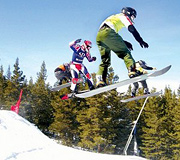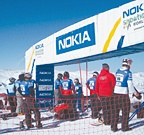Surfing the Slopes
By Editorial Staff
There are few activities as exhilarating as surfing down a snow-covered mountain with both feet strapped to a board. Wind in your hair, fresh powder gliding under your feet, the opportunity at any moment to fall face-first into a mound of snow.
For decades, snowboarding was considered a somewhat unruly alternative to skiing, embraced only by rebellious adolescents and thrill-seeking adventurers. Only 7 percent of U.S. ski areas allowed snowboarding in 1985. But all of that has changed.
Since snowboarding made its X Games debut in 1993, it has become the fastest-growing extreme winter sport, embraced by more than 3.5 million daring souls. About 97 percent of all ski areas now allow snowboarding and more than half of them have ramps and pipes. High-profile snowboarding events like the Olympics, Winter X Games and the U.S. Open are broadcast worldwide.
If you come across novice snowboarders on the slopes, you'll see how harrowing the first run down the mountain can be - struggling to stand up, falling over and over, balancing delicately all the way down the mountain. Although professional snowboarders make it look simple, even they take this first run at some point early on in their careers. The difference is, somewhere along the way, they master the art of carving through snow at 40 mph, landing jumps 20 feet in the air, turning 720 degrees in mid-air and doing tricks like alley-oops, indy grabs and rodeo flips. One of these professionals, Marc Schulz, spoke with To Your Health about the physical demands of his sport both on and off the slopes.
 When did you first jump on a snowboard? I started snowboarding back in 1989, 18 years ago. Man, does time sure fly by. I can still remember when snowboards were not even allowed on ski slopes.
When did you first jump on a snowboard? I started snowboarding back in 1989, 18 years ago. Man, does time sure fly by. I can still remember when snowboards were not even allowed on ski slopes.
When did you realize snowboarding was going to be a career for you? What did it take to turn pro? I used to compete in Minnesota in the USASA (United States Amateur Snowboard Association) Upper Midwest Point Series and took many top-three and first-place finishes. After a couple years of this, I knew I had what it took. I just needed to take it to the next level. But taking it to the next level took two to three more years of snowboarding 250-plus days a year.
What is the first big trick you learned? What is your favorite trick? I think the first big trick I learned was a front-flip indy grab, back in 1990. I think my favorite trick to date is still a fully tweaked out Grasser Method into an open field of powder going about 40 mph.
 What role has chiropractic played in your career, particularly in preventing or helping you recover from injury? Huge - chiropractic in general has kept me snowboarding longer than I ever should have been able to. Almost 15 years ago I was told I needed back surgery, but I found chiropractic. I was so lucky I did not go under the knife of a surgeon as I think this could have been the worst decision of my whole life. Not that some people don't benefit from surgery, but it was not for me. One more thing I will mention is not all chiros are the same, just like dentists. It is hard to find that one. I spoke with several sports physicians, asking who they thought was the best chiro in the area. They told me about Dr. Ted Forcum. I would have to say out of 10 different chiros I have seen in my life, Dr. Forcum stands out. I believe he is one the best in the nation. There is no question I would not even be able to snowboard without chiropractic.
What role has chiropractic played in your career, particularly in preventing or helping you recover from injury? Huge - chiropractic in general has kept me snowboarding longer than I ever should have been able to. Almost 15 years ago I was told I needed back surgery, but I found chiropractic. I was so lucky I did not go under the knife of a surgeon as I think this could have been the worst decision of my whole life. Not that some people don't benefit from surgery, but it was not for me. One more thing I will mention is not all chiros are the same, just like dentists. It is hard to find that one. I spoke with several sports physicians, asking who they thought was the best chiro in the area. They told me about Dr. Ted Forcum. I would have to say out of 10 different chiros I have seen in my life, Dr. Forcum stands out. I believe he is one the best in the nation. There is no question I would not even be able to snowboard without chiropractic.
What is your competition schedule like? How do you prepare? I will still probably show up to a few events this year. You might see me at the X Games this winter for my 10
th consecutive time.
What are the most rewarding and most challenging aspects of being a professional snowboarder? Constantly staying in shape - top shape, that is. Often times you just want to sit back and enjoy what you have worked hard to achieve, but once you do that you will no longer be on top for long. Two to three hours in the gym at least four days a week is what it takes. Being on the snow at least 150 days a year is the most challenging aspect but this is what it takes to be a champion. I think one of the most overlooked and most challenging aspects of sports in general is mental conditioning.

